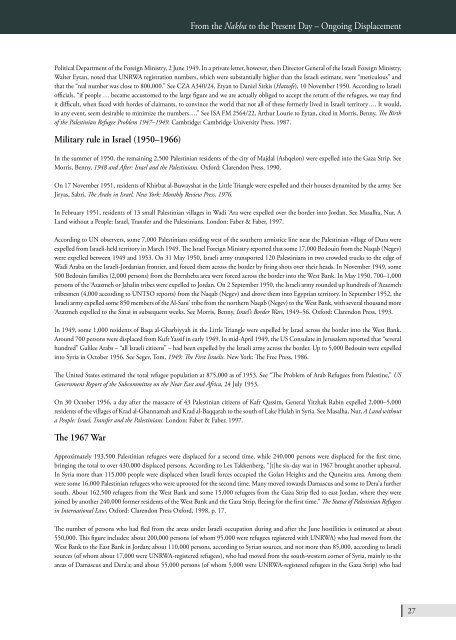BADIL Resource Center for Palestinian Residency and Refugee
BADIL Resource Center for Palestinian Residency and Refugee
BADIL Resource Center for Palestinian Residency and Refugee
You also want an ePaper? Increase the reach of your titles
YUMPU automatically turns print PDFs into web optimized ePapers that Google loves.
From the Nakba to the Present Day – Ongoing Displacement<br />
Political Department of the Foreign Ministry, 2 June 1949. In a private letter, however, then Director General of the Israeli Foreign Ministry,<br />
Walter Eytan, noted that UNRWA registration numbers, which were substantially higher than the Israeli estimate, were “meticulous” <strong>and</strong><br />
that the “real number was close to 800,000.” See CZA A340/24, Etyan to Daniel Sirkis (Hatzofe), 10 November 1950. According to Israeli<br />
officials, “if people … became accustomed to the large figure <strong>and</strong> we are actually obliged to accept the return of the refugees, we may find<br />
it difficult, when faced with hordes of claimants, to convince the world that not all of these <strong>for</strong>merly lived in Israeli territory…. It would,<br />
in any event, seem desirable to minimize the numbers….” See ISA FM 2564/22, Arthur Lourie to Eytan, cited in Morris, Benny, The Birth<br />
of the <strong>Palestinian</strong> <strong>Refugee</strong> Problem 1947–1949. Cambridge: Cambridge University Press, 1987.<br />
Military rule in Israel (1950–1966)<br />
In the summer of 1950, the remaining 2,500 <strong>Palestinian</strong> residents of the city of Majdal (Ashqelon) were expelled into the Gaza Strip. See<br />
Morris, Benny, 1948 <strong>and</strong> After: Israel <strong>and</strong> the <strong>Palestinian</strong>s. Ox<strong>for</strong>d: Clarendon Press, 1990.<br />
On 17 November 1951, residents of Khirbat al-Buwayshat in the Little Triangle were expelled <strong>and</strong> their houses dynamited by the army. See<br />
Jiryas, Sabri, The Arabs in Israel. New York: Monthly Review Press, 1976.<br />
In February 1951, residents of 13 small <strong>Palestinian</strong> villages in Wadi ‘Ara were expelled over the border into Jordan. See Masalha, Nur, A<br />
L<strong>and</strong> without a People: Israel, Transfer <strong>and</strong> the <strong>Palestinian</strong>s. London: Faber & Faber, 1997.<br />
According to UN observers, some 7,000 <strong>Palestinian</strong>s residing west of the southern armistice line near the <strong>Palestinian</strong> village of Dura were<br />
expelled from Israeli-held territory in March 1949. The Israel Foreign Ministry reported that some 17,000 Bedouin from the Naqab (Negev)<br />
were expelled between 1949 <strong>and</strong> 1953. On 31 May 1950, Israeli army transported 120 <strong>Palestinian</strong>s in two crowded trucks to the edge of<br />
Wadi Araba on the Israeli-Jordanian frontier, <strong>and</strong> <strong>for</strong>ced them across the border by firing shots over their heads. In November 1949, some<br />
500 Bedouin families (2,000 persons) from the Beersheba area were <strong>for</strong>ced across the border into the West Bank. In May 1950, 700–1,000<br />
persons of the ‘Azazmeh or Jahalin tribes were expelled to Jordan. On 2 September 1950, the Israeli army rounded up hundreds of ‘Azazmeh<br />
tribesmen (4,000 according to UNTSO reports) from the Naqab (Negev) <strong>and</strong> drove them into Egyptian territory. In September 1952, the<br />
Israeli army expelled some 850 members of the Al-Sani’ tribe from the northern Naqab (Negev) to the West Bank, with several thous<strong>and</strong> more<br />
‘Azazmeh expelled to the Sinai in subsequent weeks. See Morris, Benny, Israel’s Border Wars, 1949–56. Ox<strong>for</strong>d: Clarendon Press, 1993.<br />
In 1949, some 1,000 residents of Baqa al-Gharbiyyah in the Little Triangle were expelled by Israel across the border into the West Bank.<br />
Around 700 persons were displaced from Kufr Yassif in early 1949. In mid-April 1949, the US Consulate in Jerusalem reported that “several<br />
hundred” Galilee Arabs – “all Israeli citizens” – had been expelled by the Israeli army across the border. Up to 5,000 Bedouin were expelled<br />
into Syria in October 1956. See Segev, Tom, 1949: The First Israelis. New York: The Free Press, 1986.<br />
The United States estimated the total refugee population at 875,000 as of 1953. See “The Problem of Arab <strong>Refugee</strong>s from Palestine,” US<br />
Government Report of the Subcommittee on the Near East <strong>and</strong> Africa, 24 July 1953.<br />
On 30 October 1956, a day after the massacre of 43 <strong>Palestinian</strong> citizens of Kafr Qassim, General Yitzhak Rabin expelled 2,000–5,000<br />
residents of the villages of Krad al-Ghannamah <strong>and</strong> Krad al-Baqqarah to the south of Lake Hulah in Syria. See Masalha, Nur, A L<strong>and</strong> without<br />
a People: Israel, Transfer <strong>and</strong> the <strong>Palestinian</strong>s. London: Faber & Faber, 1997.<br />
The 1967 War<br />
Approximately 193,500 <strong>Palestinian</strong> refugees were displaced <strong>for</strong> a second time, while 240,000 persons were displaced <strong>for</strong> the first time,<br />
bringing the total to over 430,000 displaced persons. According to Lex Takkenberg, “[t]he six-day war in 1967 brought another upheaval.<br />
In Syria more than 115,000 people were displaced when Israeli <strong>for</strong>ces occupied the Golan Heights <strong>and</strong> the Quneitra area. Among them<br />
were some 16,000 <strong>Palestinian</strong> refugees who were uprooted <strong>for</strong> the second time. Many moved towards Damascus <strong>and</strong> some to Dera’a further<br />
south. About 162,500 refugees from the West Bank <strong>and</strong> some 15,000 refugees from the Gaza Strip fled to east Jordan, where they were<br />
joined by another 240,000 <strong>for</strong>mer residents of the West Bank <strong>and</strong> the Gaza Strip, fleeing <strong>for</strong> the first time.” The Status of <strong>Palestinian</strong> <strong>Refugee</strong>s<br />
in International Law, Ox<strong>for</strong>d: Clarendon Press Ox<strong>for</strong>d, 1998, p. 17.<br />
The number of persons who had fled from the areas under Israeli occupation during <strong>and</strong> after the June hostilities is estimated at about<br />
550,000. This figure includes: about 200,000 persons (of whom 95,000 were refugees registered with UNRWA) who had moved from the<br />
West Bank to the East Bank in Jordan; about 110,000 persons, according to Syrian sources, <strong>and</strong> not more than 85,000, according to Israeli<br />
sources (of whom about 17,000 were UNRWA-registered refugees), who had moved from the south-western corner of Syria, mainly to the<br />
areas of Damascus <strong>and</strong> Dera’a; <strong>and</strong> about 55,000 persons (of whom 5,000 were UNRWA-registered refugees in the Gaza Strip) who had<br />
27

















